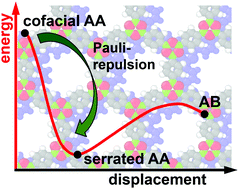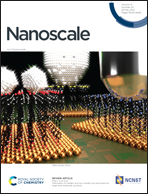Understanding the origin of serrated stacking motifs in planar two-dimensional covalent organic frameworks†
Abstract
Covalent organic frameworks (COFs) have attracted significant attention due to their chemical versatility combined with a significant number of potential applications. Of particular interest are two-dimensional COFs, where the organic building units are linked by covalent bonds within a plane. Most properties of these COFs are determined by the relative arrangement of neighboring layers. These are typically found to be laterally displaced, which, for example, reduces the electronic coupling between the layers. In the present contribution we use dispersion-corrected density-functional theory to elucidate the origin of that displacement, showing that the common notion that the displacement is a consequence of electrostatic repulsions of polar building blocks can be misleading. For the representative case of COF-1 we find that electrostatic and van der Waals interactions would, actually, favor a cofacial arrangement of the layers and that Pauli repulsion is the crucial factor causing the serrated AA-stacking. A more in-depth analysis of the electrostatic contribution reveals that the “classical” Coulomb repulsion between the boroxine building blocks of COF-1 suggested by chemical intuition does exist, but is overcompensated by attractive effects due to charge-penetration in the phenylene units. The situation becomes more involved, when additionally allowing the interlayer distance to relax for each displacement, as then the different distance-dependences of the various types of interactions come into play. The overall behavior calculated for COF-1 is recovered for several additional COFs with differently sized π-systems and topologies, implying that the presented results are of more general relevance.



 Please wait while we load your content...
Please wait while we load your content...